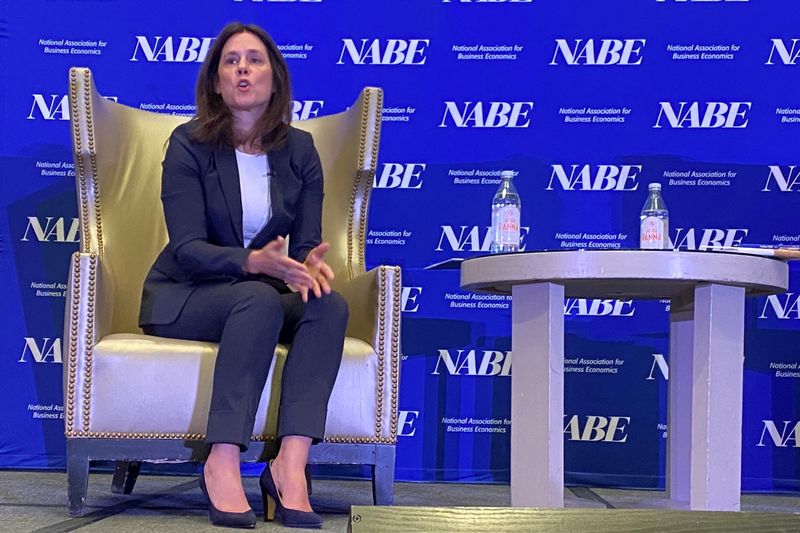Fed’s Logan: Fed will feel its way to balance sheet limit

FILE PHOTO: Federal Reserve Bank of Dallas President Lorie Logan speaks at a conference of the National Association for Business Economics in Dallas, Texas, U.S., October 9, 2023. REUTERS/Ann Saphir/File Photo
By Howard Schneider
NEW YORK (Reuters) -The U.S. Federal Reserve will need to slow its asset purchases and feel the way towards a low point for its asset holdings once a key financial buffer is exhausted, Dallas Fed president Lorie Logan said on Friday.
Logan reiterated that as long as financial institutions keep using the Fed’s overnight reverse repurchase facility, policymakers can feel confident that banks have enough reserves.
But use of the ONRRP program, at it is known, has been declining fast, from a high of around $2.3 trillion last year to about half a trillion as of the end of last month. Fed officials have begun discussing when and how to the slow the runoff of assets accumulated to try to fight the economic impact of the pandemic, and avoid hitting a point where bank reserves become scarce – a potential trigger for market volatility.
“When ONRRP balances approach a low level, it will be appropriate to slow the pace of asset runoff. As long as there are significant balances in the ONRRP facility, we can be confident that liquidity is more than ample in the aggregate,” Logan said in comments to a monetary policy forum held by the Clark Center for Global Markets at the University of Chicago’s Booth School of Business.
Once the repo facility hits zero, “there will be more uncertainty about how much excess liquidity remains.”
“I don’t think we can identify the ample level in advance. We’ll need to feel our way to it by observing money market spreads and volatility,” said Logan, former head of the markets desk at the New York Fed.
Logan’s comments were in response to a research paper documenting that the effort underway by central banks to reduce their asset holdings has had much less impact on markets than the corollary expansion of balance sheets during weakening economic conditions.
Logan said she felt the “asymmetry” was largely due to the economic context, with crises coming on fast and “quantitative easing” rolled out quickly as well; tightening programs, by contrast, are typically telegraphed far in advance leaving market adjustments likely more muted and harder to estimate.
Logan did not estimate a stopping point for the balance sheet runoff, but did side with the view, mentioned in minutes of the Fed’s January meeting, that a “slower runoff” would make the adjustment easier for banks and possibly allow a lower balance sheet overall.
Her remarks dovetail with remarks made by some policymakers at January’s policy meeting. Then, according to the meeting minutes released last week, those officials said beginning a gradual taper of QT could allow balance sheet reduction to continue for longer and result in a smaller balance sheet.
Wall Street dealers also see that as a likely outcome. The survey of bond dealers ahead of the January meeting and released last week showed firms now expect a QT taper to begin in this summer, with the end of balance sheet run down now occurring in early 2025, versus late 2024 as estimated previously, and the Fed’s final bond portfolio holdings settling at about $6.5 trillion, or around $250 billion lower than previously thought.








